Olympique Lyon have been one of the most defensively solid sides in Ligue 1 this season. Les Gones have conceded a total of 27 goals from 28 league games thus far during the 2019/20 campaign, which is a better defensive record than all but three other Ligue 1 sides.
In addition to their actual goals against record for the 2019/20 campaign, some of Lyon’s other defensive stats for the current season make for impressive reading. Firstly, Les Gones’ xGA (expected goals against) currently sits at 27.1 for the 2019/20 campaign, as per Wyscout. This gives Lyon the third-best xGA that any Ligue 1 side have managed to earn this season, trailing only PSG and Angers SCO.
Furthermore, Lyon’s average xG per shot faced is currently 0.09 according to Wyscout, which is the lowest in Ligue 1 at present. The xG (expected goals) stat provides us with a measure of the quality of a shot. It may be fair to say that Lyon have been successful at preventing their opponents from creating many high-quality goalscoring opportunities against them this term, based on these stats and their relatively impressive defensive record.
This tactical analysis piece will examine Lyon’s defensive system. In this scout report, we will analyse some of the fundamental characteristics of Rudi Garcia’s tactics when his side are playing without the ball. We will discuss what Lyon set up to do out-of-possession and examine the defensive qualities that have helped them to maintain a relatively impressive defensive record this season in this tactical analysis.
Maintaining a central overload
The first fundamental characteristic of Lyon’s defensive system which they perform to a high level is ensuring that they maintain a numerical superiority in the centre of the pitch out-of-possession.
Regardless of what formation Les Gones set up in for a particular game, they can often be seen successfully maintaining control of the centre of the pitch without the ball. This is an unwavering aspect of Garcia’s tactics which his Lyon side have managed to perform effectively during the 2019/20 campaign. They generally achieve this through the use of a particular shape which allows them to enjoy a numerical superiority in the centre in addition to effectively maintaining compactness within their defensive block.
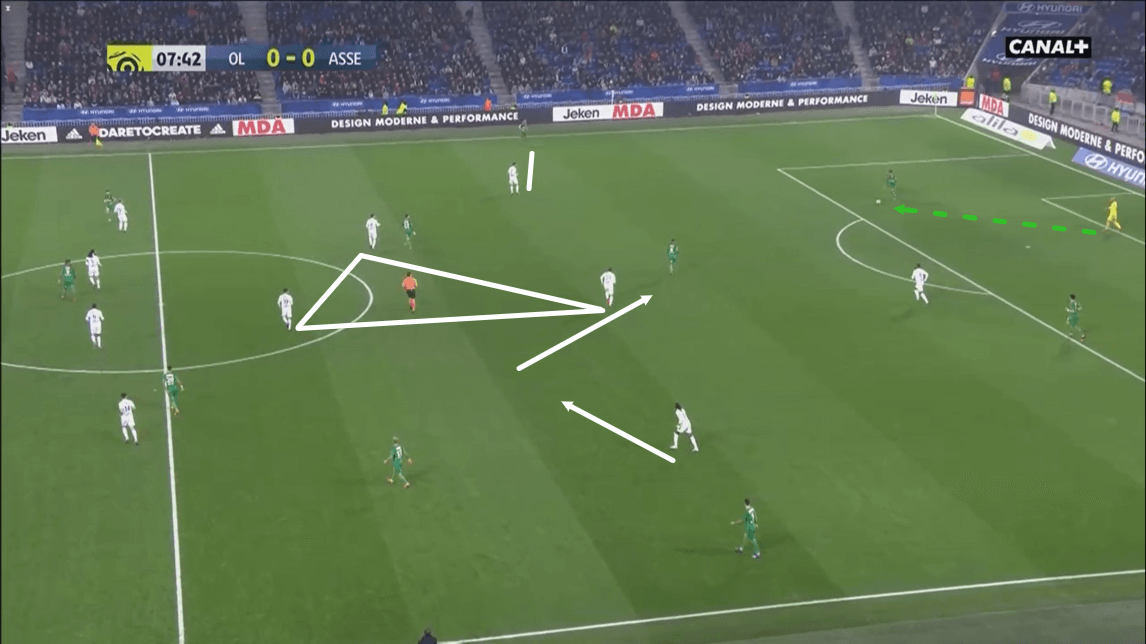
This first image which can be seen above provides us with an example of how Lyon typically control the centre of the pitch while the opposition are in the process of building out from the back. Lyon were set up in a 4-1-4-1 shape for this game, which in and of itself allows them to play with three dedicated central midfielders. Meanwhile, their opponents in this game, Saint-Étiennem deployed a 4-4-2.
As we can see in this image, Lyon enjoyed the advantage of having one extra player than their opponents in the centre of the pitch. While their two ‘8’s can be seen occupying slightly more advanced positions, marking both of their opposition’s two central midfielders, Lyon’s holding midfielder is free to screen the defence and provide an extra, free body in the centre of the pitch.
Furthermore, As Saint-Étienne play this ball out towards their right-wing, Lyon’s right-winger can be seen making his way towards the centre of the pitch as he joins his side in shifting over towards their left-wing. Les Gones’ 4-1-4-1 shape allows them to play with two wider midfielders in addition to their three central midfield players, which helps them to cover the wide areas of the pitch and shift towards the opposition’s full-backs quickly as they switch the ball, which Lyon typically allow their opponents to do without applying a great deal of pressure.
However, as they shift towards their left-wing here, Lyon’s right-winger ultimately ends up shifting into the centre, joining his teammates in maintaining a compact block. This serves to add another body to Lyon’s midfield, helping them to boost their central superiority even further.
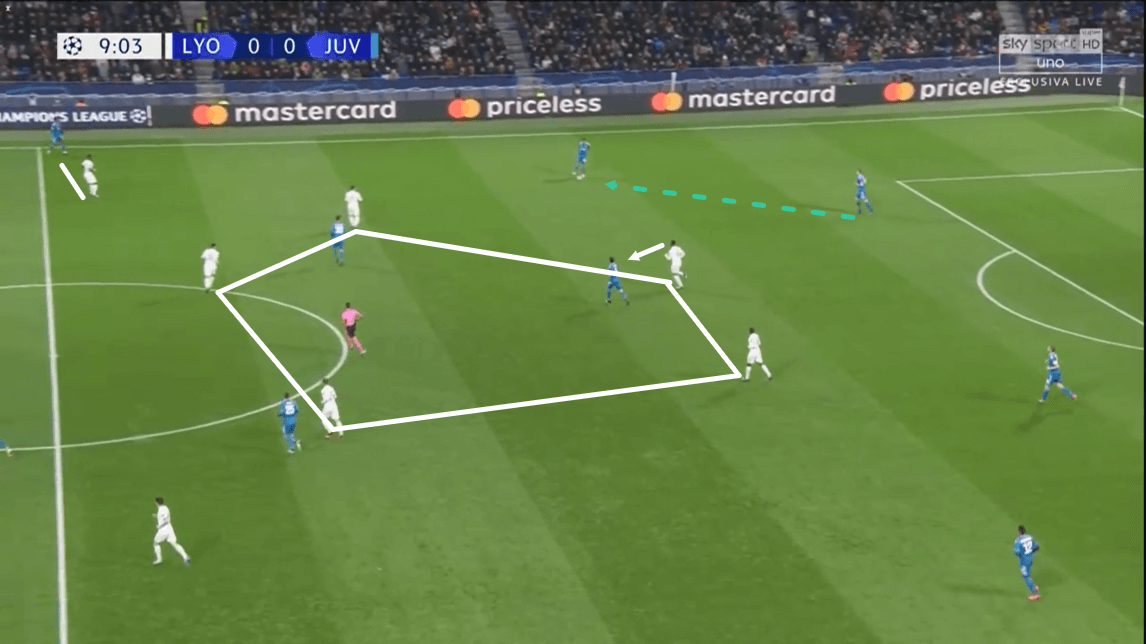
This next image provides us with another example of Lyon’s focus on maintaining a central overload when playing without the ball. In this image, Les Gones are set up in a 5-3-2 shape, which evidently looks much different to the 4-1-4-1 that we saw them utilising in the previous image.
While Lyon’s shape may be drastically different in this second image to the one that they utilised in the first image, their principle of maintaining a numerical superiority over their opponents in the centre of the pitch doesn’t change.
This image is taken from Lyon’s 1-0 win over Juventus in their 2019/20 UEFA Champions League round of 16 first-leg clash. One of the key factors to Les Gones’ success in this game was their effective control of the centre of the pitch.
Juventus were set up in a 4-3-3 for this game, as we can see in this image above. The Italian side played with one player at the base of their midfield, Miralem Pjanić in this example, playing the creative holding midfield role in Maurizio Sarri’s 4-3-3 system. In addition to that, Juventus also utilised two more advanced central midfielders who generally staggered their positioning, as we can see them doing in this image.
Lyon often chose not to press the opposition’s backline very aggressively, instead opting to ensure that they maintain control of the centre of the pitch. This match was no different as Les Gones were generally happy to allow Juventus’ backline to have the ball. As a result, their two centre forwards dropped deeper out-of-possession, essentially adding to their midfield numbers in the process. Lyon’s two forwards sat either side of Juve’s holding midfielder, Pjanić, in this game, helping their side to create a 5v3 advantage in the midfield.
As this image shows us, while Lyon didn’t press Juventus particularly aggressively, their forwards’ positioning on either side of Pjanić essentially cut off the passing lanes from both centre-backs and both full-backs into the midfielder. In addition to that, Lyon’s two ‘8’s generally ended up marking both of Juventus’ two more advanced central midfielders, while Les Gones’ holding midfielder provides an extra body once again.
This principle of Lyon’s play was implemented effectively in this game. It may be fair to say that Lyon’s midfield overload played a significant role in helping Les Gones defeat Juve 1-0 at home in this Champions League tie.
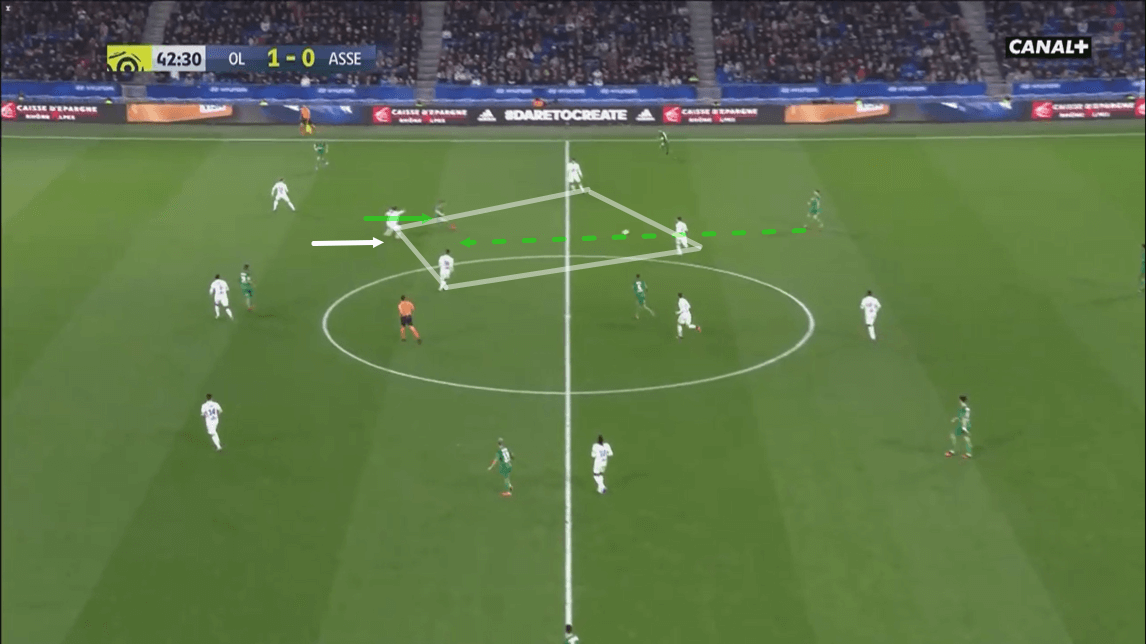
Lyon’s numbers in midfield are also effective at thwarting opposition attacks when they do manage to advance past the initial build-up phase. This next image which can be seen above provides us with an example of an occasion in which Lyon’s opponent did manage to play a pass through the lines during the build-up.
As we can see, Saint-Étienne’s right centre-back has just played a pass into one of his side’s centre forwards, who has attempted to drop into the midfield to try and get onto the ball in this passage of play. The centre-back manages to beat Lyon’s midfield trio with this pass, however, as the Saint-Étienne attacker drops into the midfield, he is followed by Lyon centre-back Jason Denayer, who doesn’t make life easy for the forward.
As the Saint-Étienne forward receives possession, he finds himself in the middle of a four-man cage of Lyon players, created by the centre-back who followed him into midfield, as well as Lyon’s holding midfielder, left central midfielder and left-winger. This cage makes it difficult for the Saint-Étienne attacker to do much with the ball upon receiving possession here.
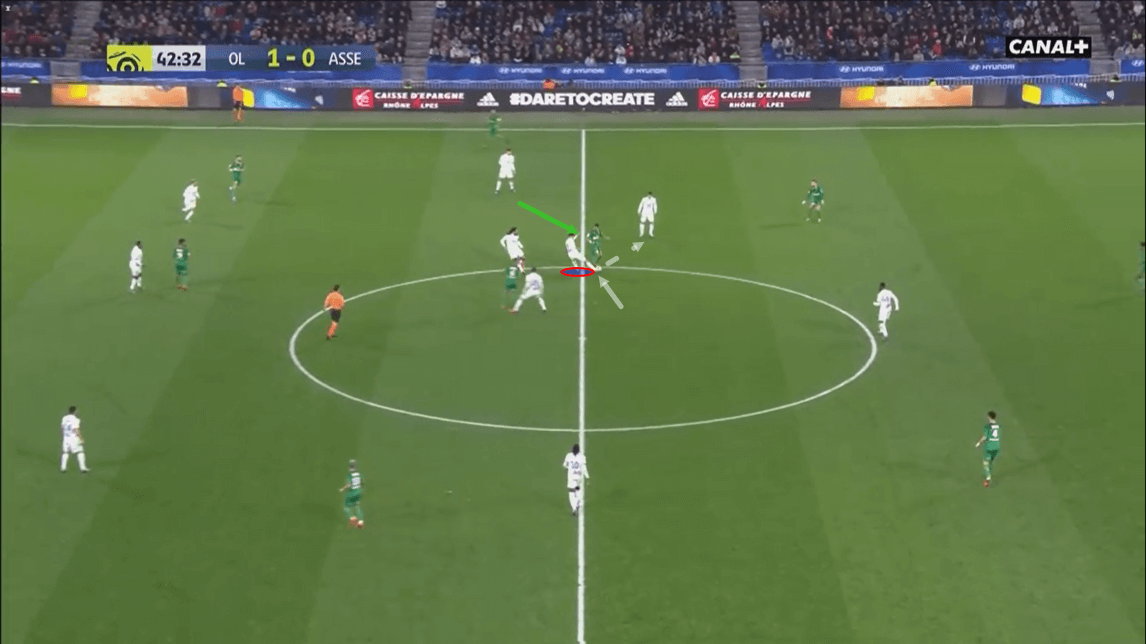
As this passage of play unfolds, the Saint-Étienne attacker takes his first touch under pressure from Denayer, which forces the ball back into the path of a Lyon player who managed to effectively dispossess the player.
This shows us the effectiveness of Lyon’s compact block which helped them to suffocate the opposition attacker as soon as he received the ball in the centre of the park. Furthermore, in addition to their compactness, Lyon’s numerical superiority in midfield played a significant role in helping them to nullify the Saint-Étienne attacker’s threat.
Lyon tend to defend quite passively
PPDA is a stat which measures the number of passes that a team allows their opponents to make before committing a defensive action in an attempt to regain possession. Lyon’s PPDA is currently the fifth-lowest in Ligue 1, as per Wyscout. This means that Lyon are one of the sides who allow their opponents to play a relatively low number of passes before pressing to win the ball back.
Furthermore, Lyon’s defensive duel intensity is measured at 5.7, as per Wyscout, which is a lower defensive duel intensity than just three other Ligue 1 sides at present. This stat basically tells us that Lyon are one of Ligue 1’s most effective sides at regaining possession when they do press for the ball.
However, Les Gones contest just 57.62 defensive duels per game according to Wyscout. This means that Lyon have contested the second-lowest number of defensive duels per game in Ligue 1 this season, as per Wyscout.
This could partially be attributed to the fact that Lyon have kept an average of 55.8% possession in the league this term. Only PSG have kept a higher average possession percentage than Lyon in Ligue 1 this season. However, this stat may also be impacted by Les Gones’ tendency to play quite passively without possession, at times.
As we discussed previously, Lyon often allow their opponents to have possession in the backline without pressing particularly aggressively. Instead, Les Gones generally tend to focus on maintaining control of the centre of the pitch and making it difficult for their opponents to play through them, rather than actively trying to dispossess their defenders.
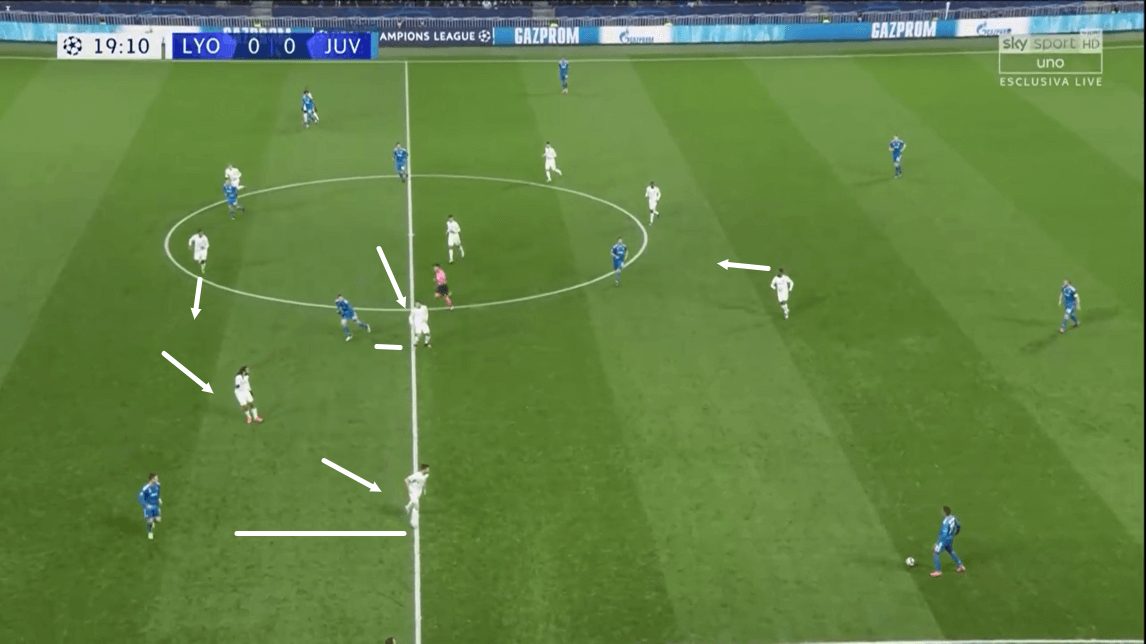
Les Gones’ recent clash with Juventus provides us with an example of some of their more passive defending, which can be seen in the image above. Firstly, this image above provides us with an example of Lyon’s compact block.
While their defensive line sits fairly high, their front two are also happy to drop quite low. This forces Juventus to play within a very restricted area of the pitch. With Lyon’s front two sitting off of the backline, they can effectively combine with the midfield three to create a central five who can effectively crowd out the centre of the pitch, forcing Juventus to go wide.
At this point, we can see that the Juve left-back has essentially got a choice between playing the ball backwards or playing a long-ball.
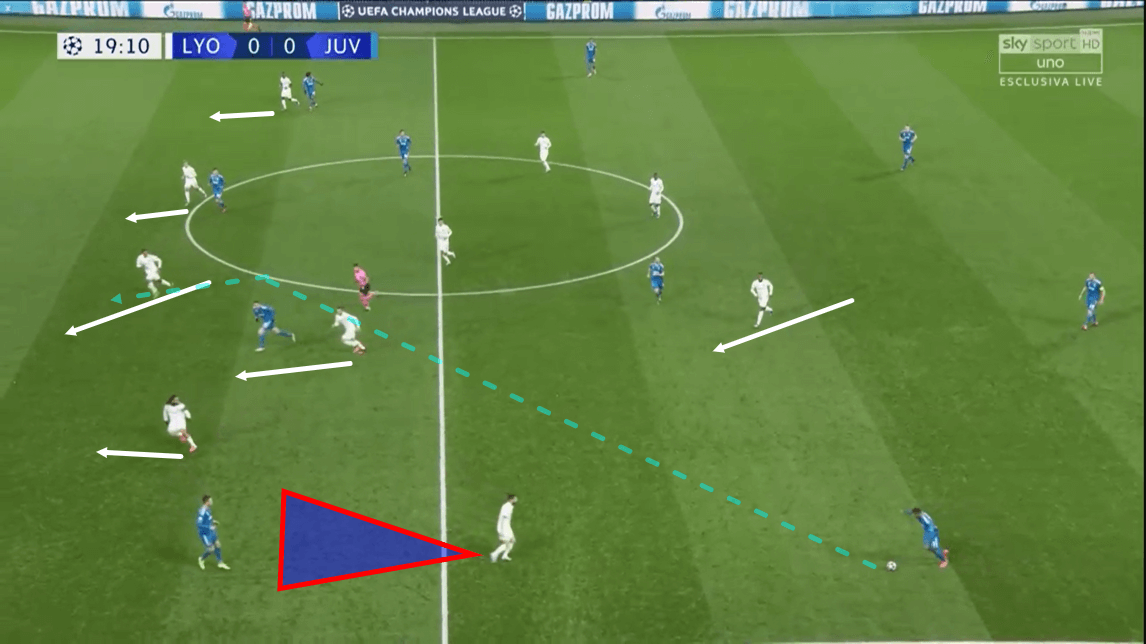
As the play moves on, we see that the Juventus left-back opts for a long-ball which is ultimately read by the Lyon backline. Lyon’s central overloads often force their opponents into wide areas, where they find themselves left with a choice between playing backwards or playing the ball long, as Juventus were in this particular passage of play.
Additionally, Lyon’s passive defensive style often forces their opponents to play the ball long, as their focus on maintaining midfield dominance often makes it difficult for the opposition to play through the lines against them. Lyon’s Brazilian centre-back Marcelo has proven particularly effective at dealing with this long-balls at times this season, having won an impressive 72.64% of his aerial duels during the 2019/20 campaign.
Lyon’s defensive shape and typically passive defensive strategy have been key in helping Les Gones to force the opposition to take riskier passing options in order to try and build out from the back against them.
Pressing triggers
While Lyon typically defend quite passively, certain opposition actions do generally trigger Les Gones’ press. When these particular scenarios occur in-game, Lyon stop defending passively and tend to start pressing the opposition more aggressively.
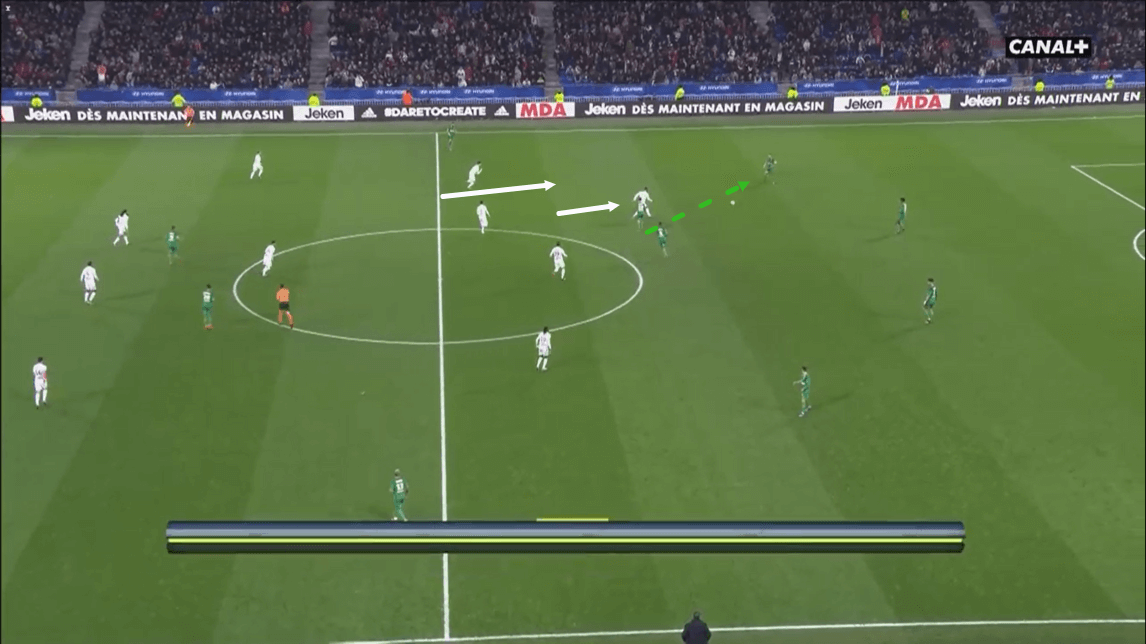
This image above provides us with an example of one of the two scenarios which we will discuss that act as pressing triggers for Lyon. In this image, we can see Saint-Étienne’s right-back preparing to receive a pass from their central midfielder, who was forced backwards having been crowded out of the midfield by Les Gones’ central overload.
As Les Verts play the ball backwards, this acts as a trigger for Lyon to begin pressing them more aggressively in an attempt to either force a mistake or force them to play the ball long, into Lyon’s compact midfield or defensive area in which they may enjoy some luck in winning the ball back.
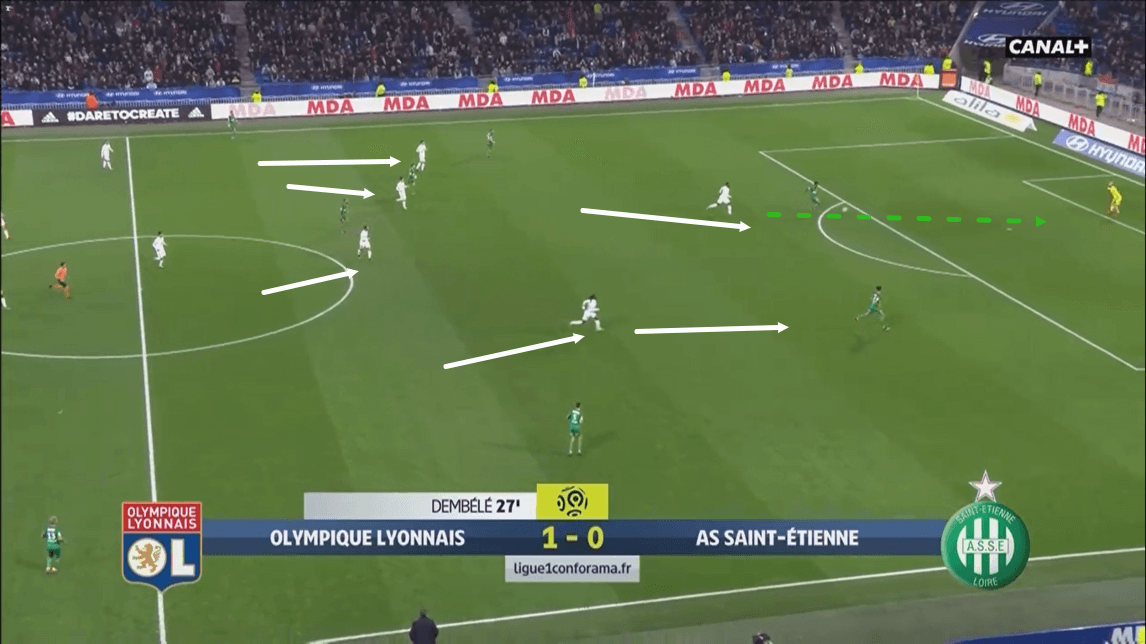
As the play moves on, we can see that Lyon’s press forced the right-back to play the ball back to the right centre-back, who we can see playing the ball back to the goalkeeper in this image above. Here, we can also see that Lyon’s midfield have joined the centre forward in advancing up the pitch towards the Saint-Étienne backline, effectively covering their potential short-passing options.
As a result, Saint-Étienne’s defence struggled to play past Lyon’s press and ultimately end up playing the ball long under pressure, allowing Les Gones to begin an attack of their own. Lyon’s aggressive press during passages of play which forces the opposition pass the ball backwards is effective as these particular scenarios allow Les Gones to quickly advance up the pitch and cover their opponent’s near passing options as they retreat into their own half.
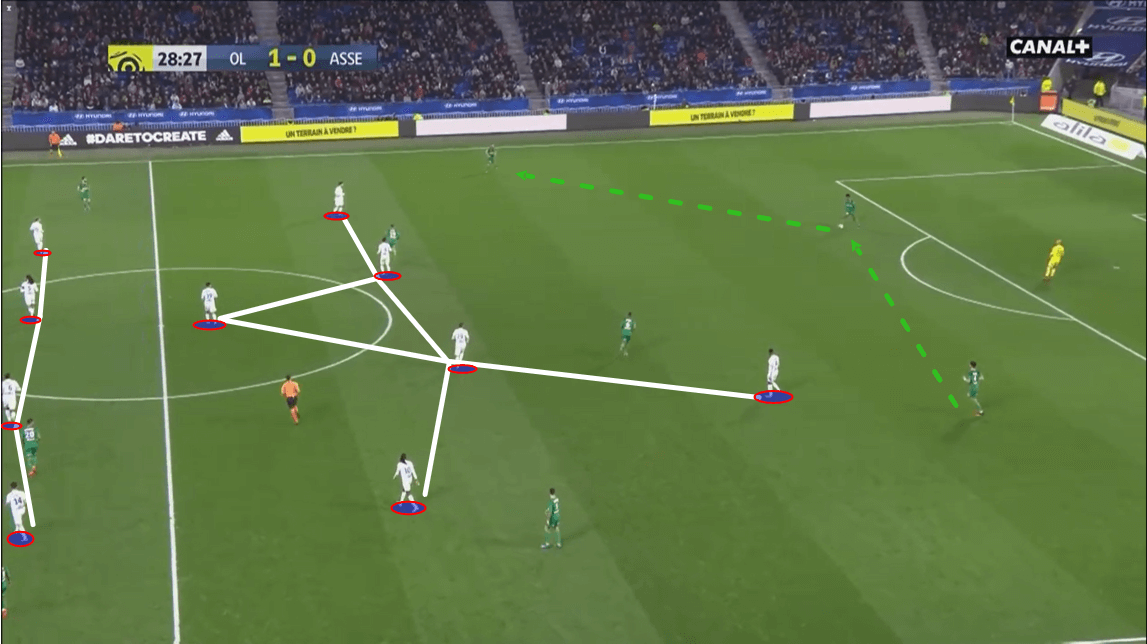
This next image shows us the beginning of another passage of play from Lyon’s recent clash with Saint-Étienne. This image provides us with a clear example of Les Gones’ 4-1-4-1 shape during the beginning phase of an opposition attack.
The Saint-Étienne goalkeeper had passed the ball to his left centre-back from the goal-kick. As Lyon’s centre forward made his way towards the centre-back, applying a slight bit of pressure, the ball carrier sent the ball over to the right centre-back, which is the point at which this image is taken.
As we can see, Lyon’s 4-1-4-1 shape allows them to maintain a numerical superiority over their opponents during this particular passage of play, however, it also allows their wingers to maintain a relatively close distance to the opposition’s full-backs, which we will refer to as ‘access’ from this point on, as this short amount of distance allows the Lyon wingers to maintain access to press the opposition full-back should they receive possession.
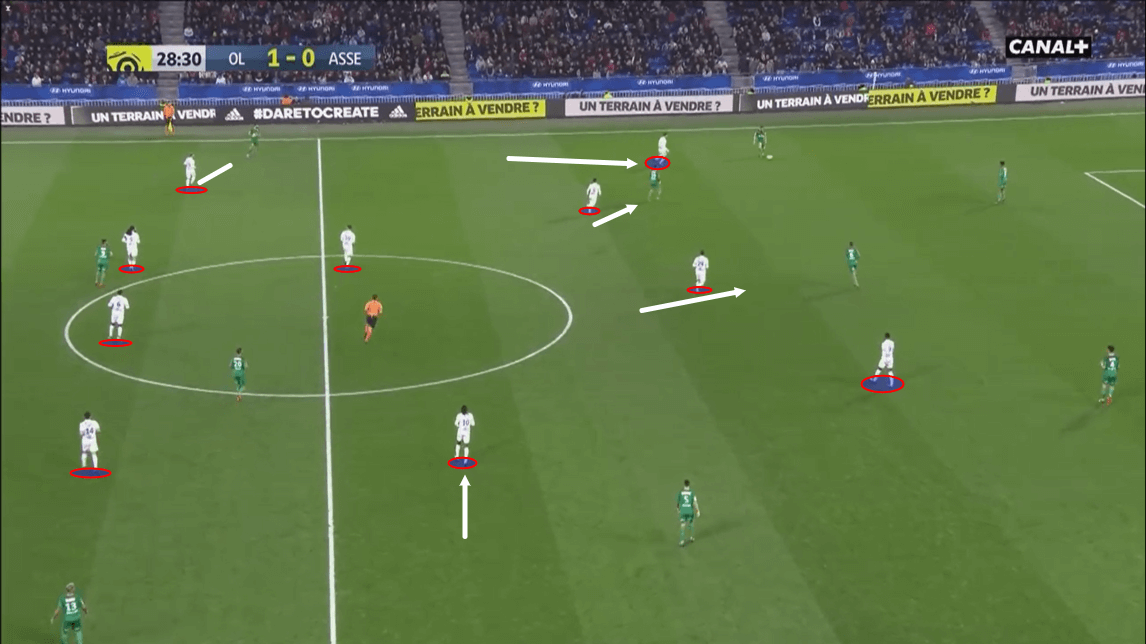
As the play moves on, the Saint-Étienne right-back does receive the ball from the right centre-back. Lyon were happy to allow the centre-back to play this pass out to the full-back, as the ball was played to the full-back it reflected another one of Lyon’s main pressing triggers.
Thanks to his wide positioning, Lyon’s winger managed to have access to the opposition right-back as he received possession. He subsequently began to press the right-back quite aggressively, while his near teammates also advanced their positions to cover the right-back’s near passing options.
As a result of this press, the Saint-Étienne defender is forced to play the ball back to the right centre-back quite quickly after receiving possession. As they play the ball backwards, Lyon continue their press in an attempt to either force Saint-Étienne long or to force them into making an error in-possession.
This pass to the full-back is an effective pressing trigger for Lyon because, due to their positioning on the pitch, the full-back is limited with regard to where they can play the ball, as they are standing right next to the sideline. This makes it easier for Lyon to cover all of the passing options near to the full-back and ultimately force them to either play the ball long or play the ball backwards.
Due to their midfield superiority, Lyon are effective at forcing their opponents to play these passes into the wide areas during the build-up phase. As a result, this may be an effective pressing trap.
Man-orientated zonal marking system
Lyon’s zonal marking system is another staple of their gameplan. While Garcia’s Lyon side practise zonal marking, their shape can often appear distorted due to the positioning of their players, who can sometimes create a shape which doesn’t resemble the one that the side were originally set up in. This is due to Lyon’s utilisation of a man-orientated zonal marking system.
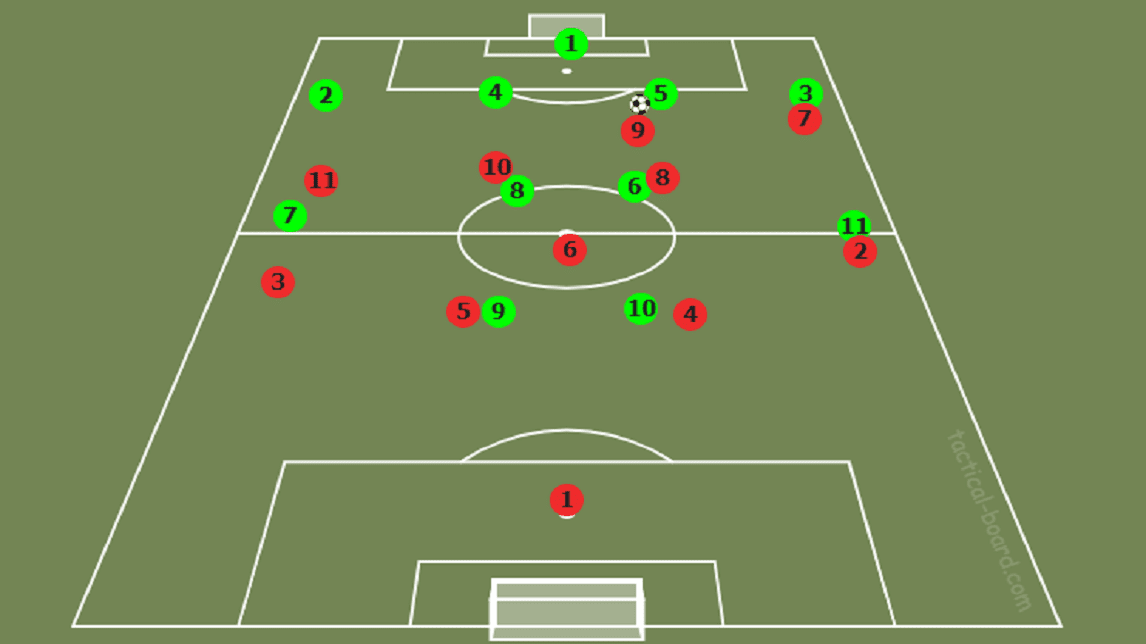
As per Wyscout, Lyon typically set themselves up in a 4-1-4-1 shape more often than not, having utilised a 4-1-4-1 in 32.6% of their Ligue 1 games this term. As a result, we will use the 4-1-4-1 to provide an example of how Lyon’s man-orientated zonal marking system works. With Les Gones being represented by the red circles and Saint-Étienne being represented by the green circles, we can see an example of Lyon’s 4-1-4-1 shape lined up against a 4-4-2 in this image above.
As we can see, the Saint-Étienne left centre-back is in possession of the ball here at the beginning of an attack. At this point, Lyon’s 4-1-4-1 shape generally looks like a 4-1-4-1, with little movement from either Lyon or the opposition at this point.
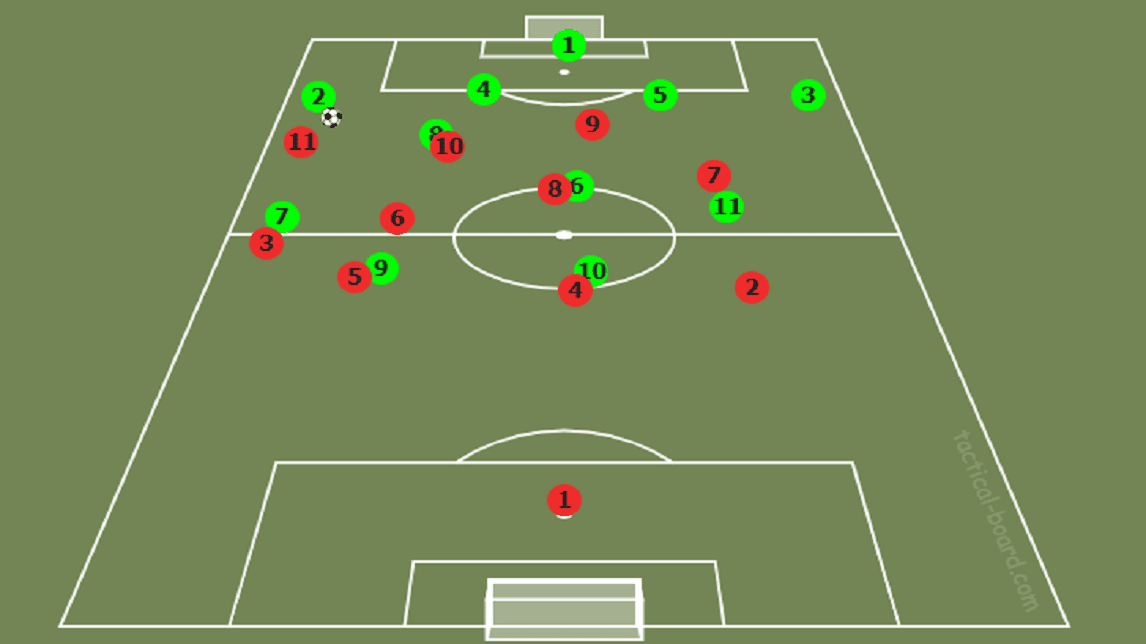
As this next image shows, Saint-Étienne have now played the ball from the left centre-back, out to the right-back. As we have discussed previously, this pass to the wide defender will typically act as a pressing trigger for Lyon, as this image above demonstrates.
The Lyon left-winger, represented by the number 11 here, begins an aggressive press upon the right-back receiving possession. The number nine, who had previously been pressing the left centre-back, will typically shift over to the right centre-back at this point.
Lyon’s pair of advanced central midfielders can also be seen occupying drastically different positions to each other at this point, with the number ‘10’, representing Lyon’s left central midfielder here, pushing up to cover the opposition midfielder closest to the right-back in-possession, while Lyon’s number ‘8’ can be seen maintaining a slightly deeper position in order to maintain access to the opposition’s ball-far central midfielder.
Meanwhile, Lyon’s holding midfielder, represented by the number ‘6’ here, has shifted across, maintaining his possession between Les Gones’ midfield and defensive line. He would typically take up a position along the ball-goal line during a passage of play such as this one, as it is important to prevent the opposition from being able to quickly advance the ball from point ‘A’, which is where the right-back in-possession currently is, to point ‘B’, the Lyon goal. In order to prevent the opposition from simply playing the ball directly towards their goal, Lyon’s holding midfielder may take up this position between the lines.
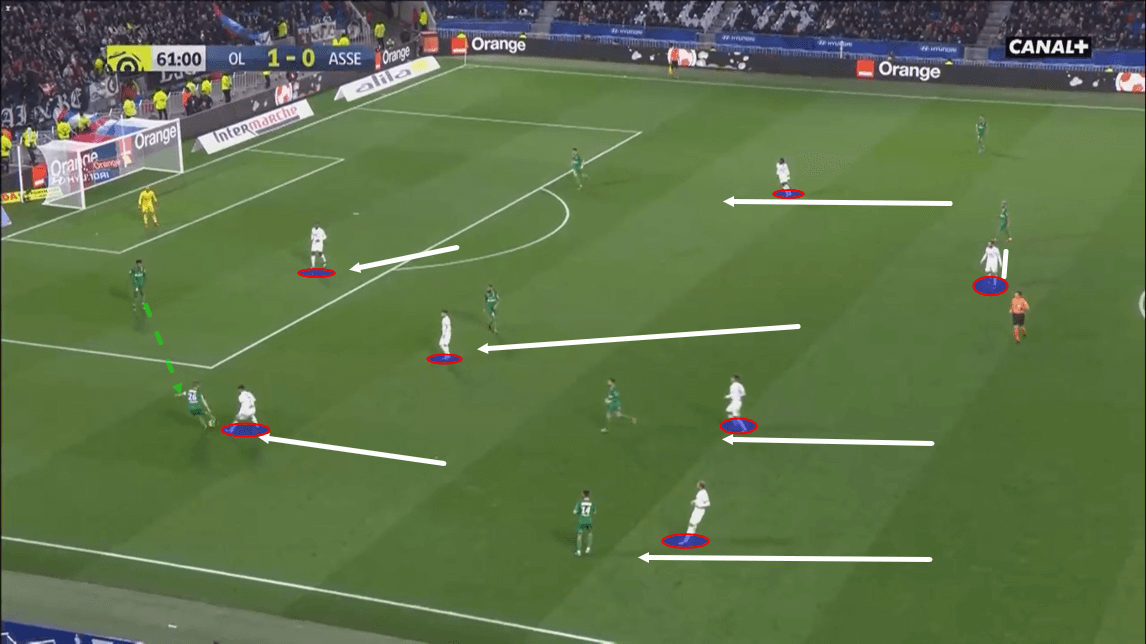
This image above provides us with an example of this type of scenario in action from Lyon’s recent Ligue 1 clash with Saint-Étienne. Here, we can see a similar situation occurring as we had previously portrayed in the images above. Lyon lined up in a 4-1-4-1 shape for this game, however, at this particular point in play, their shape looks more like a 3-3-3-1.
This simply occurs due to Lyon’s use of a man-orientated zonal marking system. While they do mark zonally and try to maintain a 4-1-4-1 shape, Lyon’s players orientate themselves based on near opposition players’ positioning. This is what results in Lyon’s pair of central midfielders, who would typically sit in the same midfield line, occupying a position in two completely different lines here.
Organisation is key for a system like this, with success hinging on the pressing team’s ability to work as a unit. Lyon have been successful at working as an effective pressing unit at times this season. As a result, it may be fair to say that their pressing system has been a success for them this term.
Conclusion
To conclude this tactical analysis piece in the form of a scout report, it may be fair to say that Lyon have been one of Ligue 1’s more well-organised and effective sides out-of-possession under Garcia.
Lyon’s defensive system consists of an emphasis on midfield dominance, in addition to some well-organised and intelligent pressing. Furthermore, Lyon’s man-orientated zonal marking system has worked out positively for them under Garcia. Their intelligent defensive system has made life difficult for the opposition both in Ligue 1 and in the UEFA Champions League during the 2019/20 campaign.




Comments